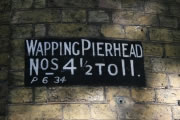Wapping Pierhead
Wapping Pier Head is situated on Wapping High Street and was once the main maritime entrance of the London Docks, spanning over 90 acres of land. By 1805, when these docks were built, the area was covered in warehouses and elegant cottage dwellings belonging to the Dock Company senior officials, customs officers and wealthy merchants who would keep a watchful eye on the ships entering and leaving the docks.
When the docks operated, Wapping High Street was covered in wagons and teams of workers stood by to unload and load the ships constantly coming in and out of the docks. The riverside wharves and dock warehouses that lined either side of the high street, were connected by iron catwalks to facilitate the secure movement of merchandise between warehouses. The imposing architecture along this street led many of its Victorian visitors to describe it as a "double-decker city".
The hubbub and chaos that characterised daily life along Wapping High Street and the London Docks epitomised the transformation of Britain's economy from its regional form until the 1600s to the growth of a more nationalised economy and the domination of merchant capital by the 1700s. Whereas in the 1600s, any industry would have been carried out by individual craftsmen making goods to order for individual customers, by the 1700s the merchant began to provide raw materials and pay a money advance to craftsmen to produce a greater quantity of goods. The merchant moved away from the sphere of trade alone and into the process of production, organising and controlling the labour of what gradually become waged handicraft workers toiling away in the growing manufactories.
The 1700s were a period of rapid change and innovation from the take-off of large scale manufacturing to the rapid succession of inventions that completely transformed productive technology; one of the greatest and best known inventions of the time being James Watt's steam machine in 1769.
It was during this period that England became popularly known as the warehouse and the workshop of the world. Its foreign trade grew rapidly between 1760 and 1815. Imports into England grew in value from 10 to 30 million £ a year and its exports rose from 15 to 59 million per year. Britain was providing factory made goods for the rest of the world, increasing its export revenues and accumulating vast capital and wealth. Simultaneously, industrialists made vast personal fortunes through large scale manufacturing.





